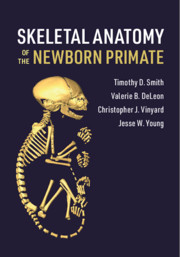Book contents
- Skeletal Anatomy of the Newborn Primate
- Skeletal Anatomy of the Newborn Primate
- Copyright page
- Contents
- Foreword
- Preface
- 1 Introduction
- 2 Primate Development and Growth
- 3 Why Ontogeny Matters
- 4 The Skull
- 5 Dentition
- 6 The Postcranial Axial Skeleton
- 7 The Pectoral Girdle and Forelimb Skeleton
- 8 The Pelvic Girdle and Hindlimb Skeleton
- 9 The Newborn Primate Body Form: Phylogenetic and Life-History Influences
- 10 Ontogeny of Feeding
- 11 Ontogeny of Locomotion
- References
- Index
- Atlas
8 - The Pelvic Girdle and Hindlimb Skeleton
Published online by Cambridge University Press: 23 March 2020
- Skeletal Anatomy of the Newborn Primate
- Skeletal Anatomy of the Newborn Primate
- Copyright page
- Contents
- Foreword
- Preface
- 1 Introduction
- 2 Primate Development and Growth
- 3 Why Ontogeny Matters
- 4 The Skull
- 5 Dentition
- 6 The Postcranial Axial Skeleton
- 7 The Pectoral Girdle and Forelimb Skeleton
- 8 The Pelvic Girdle and Hindlimb Skeleton
- 9 The Newborn Primate Body Form: Phylogenetic and Life-History Influences
- 10 Ontogeny of Feeding
- 11 Ontogeny of Locomotion
- References
- Index
- Atlas
Summary
In this chapter we discuss the osteology of the primate hindlimb and pelvic girdle of the newborn. This region in newborn hominoids (apes and humans) is discussed based on the literature and illustrated based on museum specimens. Subsequently, the hindlimb skeleton of newborn tarsiers, Old World monkeys, New World monkeys, and strepsirrhines (lemurs and lorises) are described. At birth, the os coxa of all primates is represented by three ossified elements (ilium, pubs, ischium), which are connected at synchondroses centered at the acetabulum. Generally, cercopithecoids, tarsiers, and galagids more frequently have ossified femoral and tibial epiphyses at birth than other primates. In all newborn primates, the talus and calcaneus has commenced ossification. Naviculars have commenced ossification in many strepsirrhines, tarsiers and all known cercopithecoids (but few other anthropoids). Many primate species vary in the number of tarsals ossified at birth. This chapter also includes preliminary histological observations on variations in epiphyseal growth plates of newborn, and on differing rates of early postnatal ossification of the tarsus.
Keywords
- Type
- Chapter
- Information
- Skeletal Anatomy of the Newborn Primate , pp. 191 - 219Publisher: Cambridge University PressPrint publication year: 2020



